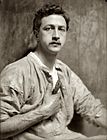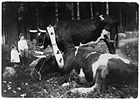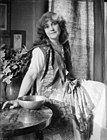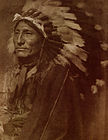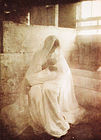Gertrude Käsebier: Difference between revisions
→Gertrude Käsebier and the Sioux: added unreferenced templates |
Richlevine00 (talk | contribs) |
||
| Line 43: | Line 43: | ||
==== Chief Iron Tail ==== |
==== Chief Iron Tail ==== |
||
[[File:Chief Iron Tail, Kasebier, 1898, Two Photos.jpg|thumbnail|350px|right|Chief Iron Tail, [[Gertrude Kasebier]], 1898, [[U.S. Library of Congress]]. Chief Iron Tail preferred the formal image.]] |
[[File:Chief Iron Tail, Kasebier, 1898, Two Photos.jpg|thumbnail|350px|right|Chief Iron Tail, [[Gertrude Kasebier]], 1898, [[U.S. Library of Congress]]. Chief Iron Tail preferred the formal image.]] |
||
Käsebier’s session with [[Iron Tail|Chief Iron Tail]] was her only recorded story: “Preparing for their visit to Käsebier’s photography studio, the [[Sioux]] at [[Buffalo Bill|Buffalo Bill's Wild West]] Camp met to distribute their finest clothing and accessories to those chosen to be photographed.” Käsebier admired their efforts, but desired to, in her own words, photograph a “real raw Indian, the kind I used to see when I was a child’, referring to her early years in [[Colorado]] and on the [[Great Plains]]. Käsebier selected one Indian, [[Iron Tail|Chief Iron Tail]], to approach for a photograph without regalia. He did not object. The resulting photograph was exactly what Käsebier had envisioned: a relaxed, intimate, quiet, and beautiful portrait of the man, devoid of decoration and finery, presenting himself to her and the camera without barriers. Several days later, however, when presented with the photograph, [[Iron Tail|Chief Iron Tail]] immediately tore up the image, stating it was too dark. Käsebier photographed him once again, this time in his full feather headdress, much to his satisfaction. [[Iron Tail|Chief Iron Tail]] was an international celebrity. He appeared with his fine regalia as the lead with [[Buffalo Bill]] at the [[Avenue des Champs-Élysées]] in [[Paris France|Paris, France,]] and the [[Coliseum]] of [[Rome, Italy|Rome]]. [[Iron Tail|Chief Iron Tail]] was a superb showman and chaffed at the photo of him relaxed. but Käsebier chose it as the frontispiece for a 1901 Everybody’s Magazine article. |
Käsebier’s session with [[Iron Tail|Chief Iron Tail]] was her only recorded story: “Preparing for their visit to Käsebier’s photography studio, the [[Sioux]] at [[Buffalo Bill|Buffalo Bill's Wild West]] Camp met to distribute their finest clothing and accessories to those chosen to be photographed.” Käsebier admired their efforts, but desired to, in her own words, photograph a “real raw Indian, the kind I used to see when I was a child’, referring to her early years in [[Colorado]] and on the [[Great Plains]]. Käsebier selected one Indian, [[Iron Tail|Chief Iron Tail]], to approach for a photograph without regalia. He did not object. The resulting photograph was exactly what Käsebier had envisioned: a relaxed, intimate, quiet, and beautiful portrait of the man, devoid of decoration and finery, presenting himself to her and the camera without barriers. Several days later, however, when presented with the photograph, [[Iron Tail|Chief Iron Tail]] immediately tore up the image, stating it was too dark. Käsebier photographed him once again, this time in his full feather headdress, much to his satisfaction. [[Iron Tail|Chief Iron Tail]] was an international celebrity. He appeared with his fine regalia as the lead with [[Buffalo Bill]] at the [[Avenue des Champs-Élysées]] in [[Paris France|Paris, France,]] and the [[Coliseum]] of [[Rome, Italy|Rome]]. [[Iron Tail|Chief Iron Tail]] was a superb showman and chaffed at the photo of him relaxed. but Käsebier chose it as the frontispiece for a 1901 Everybody’s Magazine article.<ref>Delaney, “Buffalo Bill’s Wild West Warriors: A Photographic History by Gertrude Käsebier”, Smithsonian National Museum of American History (2007), p.16-17.</ref> |
||
{{Unreferenced section|date=August 2012}} |
{{Unreferenced section|date=August 2012}} |
||
==== Chief Flying Hawk ==== |
==== Chief Flying Hawk ==== |
||
[[File:Chief Flying Hawk, Gertrude Kasebier, 1898.jpg|thumbnail|left|[[Flying Hawk|Chief Flying Hawk]], Gertrude Kasebier, 1898, [[U.S. Library of Congress]]]] |
[[File:Chief Flying Hawk, Gertrude Kasebier, 1898.jpg|thumbnail|left|[[Flying Hawk|Chief Flying Hawk]], Gertrude Kasebier, 1898, [[U.S. Library of Congress]]]] |
||
Revision as of 19:11, 30 August 2012
Gertrude Käsebier | |
|---|---|
 "Portrait of the Photographer" - manipulated self-portrait by Gertrude Käsebier | |
| Born | May 18, 1852 Des Moines, Iowa, U.S. |
| Died | October 12, 1934 New York City, New York, U.S. |
Gertrude Käsebier (1852–1934) was one of the most influential American photographers of the early 20th century. She was known for her evocative images of motherhood, her powerful portraits of Native Americans and her promotion of photography as a career for women.
Life
Early life (1852–1873)
Käsebier was born Gertrude Stanton on 18 May 1852 in Fort Des Moines (now Des Moines. Her father, John W. Stanton, transported a saw mill to Golden, Colorado at the start of the Pike's Peak Gold Rush of 1859, and he prospered from the building boom that followed. In 1860 eight-year-old Stanton traveled with her mother and younger brother to join her father in Colorado. That same year her father was elected the first mayor of Golden, which was then the capital of the Colorado Territory.[2]
After the sudden death of her father in 1864, the family moved to Brooklyn, New York, where her mother, Muncy Boone Stanton, opened a boarding house to support the family.[3] From 1866-70 Stanton lived in Bethlehem, Pennsylvania with her maternal grandmother and attended the Bethlehem Female Seminary (later called Moravian College). Little else is known about her early years.
Becoming a photographer (1874–1897)
On her twenty-second birthday, in 1874, she married twenty-eight year old Eduard Käsebier, a financially comfortable and socially well-placed businessman in Brooklyn.[2] The couple soon had three children, Frederick William (1875-?), Gertrude Elizabeth (1878-?) and Hermine Mathilde (1880-?). In 1884 they moved to a farm in New Durham, New Jersey, in order to provide a healthier place to raise their children.
Käsebier later wrote that she was miserable throughout most of her marriage. She said, "If my husband has gone to Heaven, I want to go to Hell. He was terrible…Nothing was ever good enough for him.”[2] At that time divorce was considered scandalous, and the two remained married while living separate lives after 1880. This unhappy situation would later serve as an inspiration for one of her most strikingly titled photographs – two constrained oxen, entitled Yoked and Muzzled – Marriage (c1915).
In spite of their differences, her husband supported her financially when she began to attend art school at the age of thirty-seven, a time when most women of her day were well-settled in their social positions. Käsebier never indicated what motivated her to study art, but she devoted herself to it wholeheartedly. Over the objections of her husband in 1889 she moved the family back to Brooklyn in order to attend the newly established Pratt Institute of Art and Design full-time. One of her teachers there was Arthur Wesley Dow, a highly influential artist and art educator. He would later help promote her career by writing about her work and by introducing her to other photographers and patrons.
While at Pratt Käsebier learned about the theories of Friedrich Fröbel, a 19th century scholar whose ideas about learning, play and education led to the development of the first kindergarten. His concepts about the importance of motherhood in child development greatly influenced Käsebier, and many of her later photographs would emphasize the bond between mother and child.[2]
She formally studied drawing and painting, but she quickly became obsessed with photography. Like many art students of that time, Käsebier decided to travel to Europe in order to further her education. She began 1894 by spending several weeks studying the chemistry of photography in Germany, where she was also able to leave her daughters with in-laws in Wiesbaden. She spent the rest of the year in France, studying with American painter Frank DuMond.[2]
In 1895 she returned to Brooklyn. In part because her husband was now quite ill and her family's finances were strained, she determined to become a professional photographer. A year later she became an assistant to Brooklyn portrait photographer Samuel H. Lifshey, where she learned how to run a studio and expand her knowledge of printing techniques. It is clear, however, that by this time she already had an extensive mastery of photography. Just one year later she exhibited 150 photographs, an enormous number for an individual artist at that time, at the Boston Camera Club. These same photos were shown in February 1897 at the Pratt Institute.[2]
The success of these shows led to another at the Photographic Society of Philadelphia in 1897. She also lectured on her work there and encouraged other women to take up photography as a career, saying, "I earnestly advise women of artistic tastes to train for the unworked field of modern photography. It seems to be especially adapted to them, and the few who have entered it are meeting a gratifying and profitable success."[2]
Gertrude Käsebier and the Sioux
Photographing the Sioux
In 1898, Käsebier watched Buffalo Bill’s Wild West troupe parade past her Fifth Avenue studio in New York City, New York, toward Madison Square Garden. Her memories of affection and respect for the Lakota people inspired her to send a letter to William “Buffalo Bill” Cody requesting permission to photograph Sioux traveling with the show in her studio. Cody and Käsebier were similar in their abiding respect for Native American culture and maintained friendships with the Sioux. Cody quickly approved Käsebier’s request and she began her project on Sunday morning, April 14, 1898. Käsebier’s project was purely artistic and her images were not made for commercial purposes and never used in Buffalo Bill’s Wild West program booklets or promotional posters.[4] Käsebier took classic photographs of the Sioux while they were relaxed. Chief Iron Tail and Chief Flying Hawk were Käsebier’s most challenging and revealing portraits.
Chief Iron Tail
Käsebier’s session with Chief Iron Tail was her only recorded story: “Preparing for their visit to Käsebier’s photography studio, the Sioux at Buffalo Bill's Wild West Camp met to distribute their finest clothing and accessories to those chosen to be photographed.” Käsebier admired their efforts, but desired to, in her own words, photograph a “real raw Indian, the kind I used to see when I was a child’, referring to her early years in Colorado and on the Great Plains. Käsebier selected one Indian, Chief Iron Tail, to approach for a photograph without regalia. He did not object. The resulting photograph was exactly what Käsebier had envisioned: a relaxed, intimate, quiet, and beautiful portrait of the man, devoid of decoration and finery, presenting himself to her and the camera without barriers. Several days later, however, when presented with the photograph, Chief Iron Tail immediately tore up the image, stating it was too dark. Käsebier photographed him once again, this time in his full feather headdress, much to his satisfaction. Chief Iron Tail was an international celebrity. He appeared with his fine regalia as the lead with Buffalo Bill at the Avenue des Champs-Élysées in Paris, France, and the Coliseum of Rome. Chief Iron Tail was a superb showman and chaffed at the photo of him relaxed. but Käsebier chose it as the frontispiece for a 1901 Everybody’s Magazine article.[5]
Chief Flying Hawk

Chief Flying Hawk’s glare is the most startling of Käsebier’s portraits. Other Indians were able to relax, smile or do a “noble pose.” Chief Flying Hawk was a combatant in nearly all of the fights with United States troops during the Great Sioux War of 1876. Chief Flying Hawk fought along with his cousin Crazy Horse and his brothers Kicking Bear and Black Fox II in the Battle of the Little Big Horn in 1876, and was present at the death of Crazy Horse in 1877 and the Wounded Knee Massacre of 1890. In 1898, Chief Flying Hawk was new to show business and unable to hide his anger and frustration imitating battle scenes and from the Great Plains Wars with Buffalo Bill’s Wild West to escape the constraints and poverty of the Indian reservation. Soon, Chief Flying Hawk learned to appreciate the benefits of a Show Indian with Buffalo Bill’s Wild West. Chief Flying Hawk regularly circulated show grounds in full regalia and sold his “cast card” picture postcards for a penny to supplement promote the show and supplement his meager income. After Chief Iron Tail’s death on May 28, 1916, Chief Flying Hawk was chosen as successor by all of the braves of Buffalo Bill’s Wild West and led the gala processions as the head Chief of the Indians.
Height of her career (1898–1909)
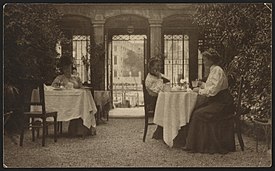
In the late 1890s Käsebier heard about a theatrical performance of cowboys, Indians and other American West characters called Buffalo Bill's Wild West". The show was performing in New York and had temporarily set up an "Indian village" in Brooklyn. Recalling her early days in Colorado, Käsebier went to the show and became enthralled with the faces of the Native Americans. She began taking portraits of them and soon became sympathetic to their plight. Over the next decade she would take dozens of photographs of the Indians in the show, some of which would become her most famous images.
Unlike her contemporary Edward Curtis, Käsebier focused more on the expression and individuality of the person than the costumes and customs. While Curtis is known to have added elements to his photographs to emphasize his personal vision, Käsebier did the opposite, sometimes removing genuine ceremonial articles from a sitter in order to concentrate on the face or stature of the person.[2]
In July 1899 Alfred Stieglitz published five of Käsebier's photographs in Camera Notes, declaring her “beyond dispute, the leading artistic portrait photographer of the day.”[6] Her rapid rise to fame was noted by photographer and critic Joseph Keiley, who wrote "a year ago Käsebier's name was practically unknown in the photographic world...Today that names stands first and unrivaled...".[7] That same year her print of "The Manger" sold for $100, the most ever paid for a photograph at that time.[8]
In 1900 Käsebier continued to gather accolades and professional praise. In the catalog for the Newark (Ohio) Photography Salon, she was called "the foremost professional photographer in the United States."[8] In recognition of her artistic accomplishments and her stature, later that year Käsebier was one of the first two women elected to Britain's Linked Ring (the other was British pictorialist Carine Cadby).
The next year Charles H. Caffin published his landmark book Photography as a Fine Art and devoted an entire chapter to the work of Käsebier ("Gertrude Käsebier and the Artistic Commercial Portrait").[9] Due to demand for her artistic opinions in Europe, Käsebier spent most of the year in Britain and France visiting with F. Holland Day and Edward Steichen.
In 1902 Stieglitz included Käsebier as a founding member of the Photo-Secession. The following year Stieglitz published six of her images in the first issue of Camera Work, along with highly complementary articles by Charles Caffin and Frances Benjamin Johnston.[10] In 1905 six more of her images were published in Camera Work, and the following year Stieglitz gave her an exhibition (along with Clarence H. White) at his Little Galleries of the Photo-Secession.
The strain of balancing her professional life with her personal one began to take a toll on Käsebier about this time. The stress was exacerbated by her husband's decision to move to Oceanside, Long Island, which had the effect of distancing her from the New York's artistic center. To counter his action, she returned to Europe, where, through Steichen's connections, she was able to photograph the reclusive Auguste Rodin.
When Käsebier came back to New York, she found herself in an unexpected personality clash with Stieglitz. Käsebier's strong interests in the commercial side of photography, driven by her need to support her husband and family, were directly at odds with Stieglitz's idealistic and anti-materialistic nature. The more Käsebier enjoyed commercial success, the more Stieglitz felt she was a going against what he felt a true artist should emulate.[2] In May 1906 Käsebier joined the Professional Photographers of New York, a newly formed organization that Stieglitz saw as standing for everything he disliked – commercialism and selling photographs for money rather than love of the art. After this he began distancing himself from Käsebier, and their relationship never regained its previous status of mutual artistic admiration.
Professional independence (1910–1934)
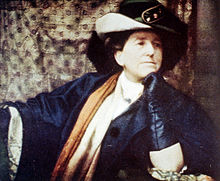
Eduard Käsebier died in 1910, finally leaving his wife free to pursue her interests as she saw fit. She continued to take a separate course from Stieglitz by helping to establish the Women's Professional Photographers Association of America. In turn, Stieglitz began to publicly speak against her work, although he still thought enough of her earlier images to include twenty-two of them in the landmark exhibition of pictorialists at the Albright-Knox Art Gallery later that year.
The next year Käsebier was shocked by a highly critical attack by her former admirer Joseph T. Keiley, published in Stieglitz's Camera Work. It's unknown why Keiley suddenly changed his opinion of her, but Käsebier suspected that Stieglitz had put him up to it.[2]
Part of Käsebier's alienation from Stieglitz was due to his stubborn resistance to the idea of gaining financial success from artistic photography. He often sold original prints by Käsebier and others at far less than their market value if he felt a buyer truly appreciated the art, and when he did sell prints he took many months to finally pay the photographer in question. After several years of protesting these practices, in 1912 Käsebier became the first member to resign from the Photo-Secession.
In 1916 Käsebier helped Clarence H. White found the group Pictorial Photographers of America,[11] which was seen by Stieglitz as a direct challenge to his artistic leadership. By this time, Stieglitz's tactics had offended many of his former friends, including White and Robert Demachy, and a year later he was forced to disband the Photo-Secession.
During this time many young women starting out in photography sought out Käsebier, both for her photography artistry and inspiration as an independent woman. Among those who were inspired by Käsebier and who went on to have successful careers of their own were Clara Sipprell, Consuelo Kanaga and Laura Gilpin.
Throughout the late 1910s and most of the 1920s Käsebier continued to expand her portrait business, taking photos of many important people of the time including Robert Henri, John Sloan, William Glackens, Arthur B. Davies, Mabel Dodge and Stanford White. In 1924 her daughter Hermine Turner joined her in her portrait business.
In 1929 Käsebier gave up photography altogether and liquidated the contents of her studio. That same year she was given a major one-person exhibition at the Booklyn Institute of Arts and Sciences.
Käsebier died on 12 October 1934 at the home of her daughter, Hermione Turner.
A major collection of her work is held by the University of Delaware.
Gallery
-
Miss N
(Portrait of Evelyn Nesbit), 1903 -
Clarence White Sr.,
1897-1910 -
Blessed Art Thou among Women, ca.1899 -
Portrait of Alfred Stieglitz, 1902 -
Auguste Rodin, 1905 -
Chester Beach, 1910 -
Portrait of George Luks (American painter), ca.1910 -
The Clarence White Family in Maine
(American photographer), 1913 -
John Murray Anderson, ca.1914-1916 -
Yoked and Muzzled Marriage, ca.1915 -
Rose O'Neill, ca.1907 -
Portrait of Robert Henri (American painter), ca.1907 -
Dorothy, ca.1900 -
Indian Chief, ca.1901 -
The Manger, ca.1899 -
The Red Man, 1903
References
- ^ Weston J. Naef (2004), Photographers of Genius at the Getty, Getty Publications, p. 76.
- ^ a b c d e f g h i j Barbara L. Michaels (1992). Gertrude Käsebier, The Photographer and Her Photographs. NY: Abrams. pp. 13–14, 26, 28–30, 42, 44, 46–60.
- ^ Bronwyn A. E. Griffith (2001). Ambassadors of Progress: American Women Photographers in Paris, 1900-1901. Hanover: University Press of New England. pp. 157–158.
- ^ Delaney, “Buffalo Bill’s Wild West Warriors: A Photographic History by Gertrude Käsebier”, Smithsonian National Museum of American History (2007).
- ^ Delaney, “Buffalo Bill’s Wild West Warriors: A Photographic History by Gertrude Käsebier”, Smithsonian National Museum of American History (2007), p.16-17.
- ^ Alfred Stieglitz (1899). "Our Illustrations". Camera Notes. 3 (1): 24.
{{cite journal}}: Unknown parameter|month=ignored (help) - ^ Joseph T. Keily (1899). "The Philadelphia Salon: Its Origin and Influence". Camera Notes. 1 (3): 126.
{{cite journal}}: Unknown parameter|month=ignored (help) - ^ a b Weston Naef (1978). The Collection of Alfred Stieglitz: Fifty Pioneers of Modern Photography. NY: Metropolitan Museum of Art. pp. 387–88.
- ^ Charles H. Caffin (1901). Photography as a Fine Art. NY. pp. 51–81.
- ^ Jonathan Green (1973). Camera Work: A Critical Anthology. NY: Aperture. p. 338.
- ^ Heilbrunn Timeline of Art History. "Pictorialism in America". Retrieved 2008-10-03.






